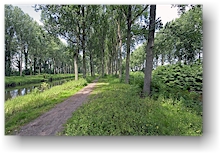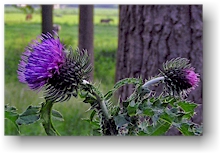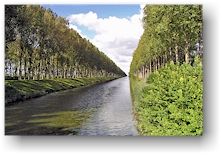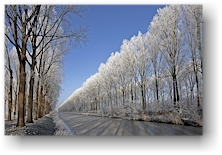|
» Den Hoorn » Moerkerke » Oostkerke » Middelburg » Maldegem » Damse Vaart » Domain Ryckevelde » NR town walls of Damme » NR fortress Saint-Donaas » NR Platte Kreek » Batreserve » Birdlife » NR Zwin |
Doublecanal (Leopoldcanal and Schipdonkcanal)
Although it is so peaceful an quiet here, it was not always like that . In 1944, the allied advance was stopped here (temporarily). While most of Belgium was liberated, this small area north of the canals remained occupied territory until November 1944. If you want to know more about it, please read about it on the separate page over the battle for "Het Molentje".
This unnavigeable waterway was dug in 1845 and runs from Boekhoute (Braakman) till Heist and serves for drainage of the surrounding polders. The origin of the canal lies in the independence of Belgium. Before Belgium existed, the superfluous water from the polders was diverted to the sea via a creek called the "Lapscheurse Gat", which is nowadays partially the border between Belgium and the Netherlands. After 1830 our nothern neighbours were not our best friends for quite some time. As a result of the declaration of independence, the sluices were blocked by the Dutch. By consequence the water could not escape to the sea anymore and stayed on the lands, making them water sick. To solve this problem, the Leopoldcanal was dug. This canal has the nickname the "Blinker" (the pure one) because it was the cleanest of both canals. Oh yes, nowadays we are the best of friends with the Dutch!
This canal was dug in 1852 and is a diversion channel for the redundant water of the river Lys. This canal is navigeable up to Balgerhoeke (more upstream towards Ghent). This canal also has a nickname: the "Stinker". This name comes from an industrial acitivity on the river Lys called "retting of flax". This activity was very polluting and created a very penetrating smell. Since the water of the Lys was diverted via this canal, the polluted water and the smell also passed here. Nowadays, retting of flax happens no longer and the water has become cleaner, so that there is again fish in the canal. And in case you might have a doubt: this landscape is breathtaking in every season. |
|
 One
of the most well-known panoramas of the area are without any doubt the
combination of both canals: Leopold- and Schipdonkcanal, commonly often referred
to as the "Blinker" and the "Stinker". As from Strobrugge, a hamlet of
One
of the most well-known panoramas of the area are without any doubt the
combination of both canals: Leopold- and Schipdonkcanal, commonly often referred
to as the "Blinker" and the "Stinker". As from Strobrugge, a hamlet of
 In
In
 Leopoldcanal
(the "Blinker")
Leopoldcanal
(the "Blinker") Schipdonkcanal
(the "Stinker")
Schipdonkcanal
(the "Stinker")